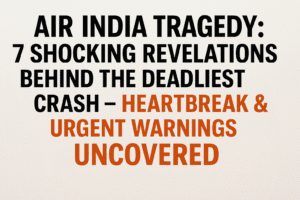Air India Tragedy: 7 Shocking Revelations Behind the Deadliest Crash – Heartbreak & Urgent Warnings Uncovered
Recovery of Air India flight AI171’s cockpit voice recorder offers investigators critical clues, but the human tragedy deepens as families endure an agonizing wait for DNA confirmation of their loved ones. Only 80 of 279 victims have been identified four days after the Ahmedabad crash, leaving relatives like Rinal Christian questioning their future after losing family breadwinners. The sole survivor recounts witnessing “people dying in front of my eyes,” while multinational vigils reflect the global scale of loss. Investigators examine the captain’s last-minute mayday call alongside potential mechanical failures in engines, flaps, or landing gear.
Air India’s chairman calls this his “most heartbreaking crisis,” urging staff to rebuild safety culture as the carrier grounds its 787 fleet. While global airlines continue flying Dreamliners, the unprecedented crash places scrutiny on maintenance practices, human factors, and Boeing’s flagship model. Beyond technical analysis, the disaster underscores aviation’s profound human cost—where meticulous identification processes, shattered livelihoods, and unanswered “what next?” questions now define a grieving community.

Air India Tragedy: 7 Shocking Revelations Behind the Deadliest Crash – Heartbreak & Urgent Warnings Uncovered
The recovery of the second black box from the wreckage of Air India flight AI171 marks a critical, yet somber, step in understanding one of aviation’s darkest hours. While the cockpit voice recorder holds the potential to reveal the pilots’ final, desperate moments, the human cost of the crash in Ahmedabad continues to unfold with agonizing slowness, overshadowing the technical investigation.
A City, and the World, in Mourning:
For hundreds of families, the pain is visceral and immediate. The promise of DNA identification within 48 hours has stretched into a torturous fourth day for many. Rajnish Patel, a doctor at Ahmedabad’s civil hospital, confirmed only about 80 of the 279 victims (including 38 on the ground) had been identified by late Sunday, emphasizing the “meticulous and slow” nature of the process. The anguish is palpable in the words of Rinal Christian, 23, awaiting news of his brother, the family’s sole breadwinner: “So what happens next?” His question echoes the uncertainty facing countless others.
The grief transcends borders. In London, members of the UK’s Indian community held a multi-faith vigil, a poignant reminder of the international tapestry torn apart – 169 Indian passengers, 53 British, seven Portuguese, a Canadian, and 12 crew members lost. The sole survivor, British national Vishwash Kumar Ramesh, carries the unimaginable burden of witnessing “people dying in front of [his] eyes.”
The Weight of the Investigation:
As Indian authorities, aided by experts from the UK and US, prepare to analyze the cockpit voice recordings alongside the previously recovered flight data, the technical focus remains on potential catastrophic failures: engines, wing flaps, or landing gear. The chilling detail that Captain Sumeet Sabharwal issued a mayday call mere seconds after takeoff underscores the suddenness and severity of the crisis.
However, the scope is necessarily wider:
- Human Factors: Pilot actions, training, and potential error under extreme duress will be scrutinized.
- Maintenance & Airline Oversight: Air India, owned by Tata Group and undergoing a major revamp, faces intense scrutiny regarding its maintenance protocols for its ageing fleet, including the specific history of this 787 Dreamliner. The airline’s immediate grounding of its 787 fleet for “additional maintenance and checks” is a procedural response, but the investigation will delve deeper.
- Aircraft Integrity: While this is the first fatal crash involving a Boeing 787 (with over 1,000 in service globally), every component and system certification will be re-examined in light of this unprecedented event. Boeing’s scaled-back presence at the Paris Airshow and its team on the ground in Ahmedabad reflect the gravity of the situation.
Leadership in the Shadow of Tragedy:
Air India Chairman N. Chandrasekaran addressed staff, calling this the “most heartbreaking crisis” of his career. His message struck a crucial balance: urging resilience against criticism while demanding that the crash become a catalyst: “We need to use this incident as an act of force to build a safer airline.” He acknowledged the complexity and inherent safety redundancies of modern aircraft, emphasizing the need to “wait for the investigation” to understand why these layers failed. His words highlight the immense pressure on the airline to rebuild trust while navigating profound grief.
Beyond the Headlines: The Unseen Anguish:
The tragedy is compounded by the sheer scale of loss and the logistical nightmare of identification. The unnamed family instructed not to open the coffin they receive speaks volumes about the condition of the remains and the profound trauma inflicted. The funeral of a former Gujarat chief minister, conducted with state honours, contrasts starkly with the private, agonizing waits of countless others for even a fragment of closure.
A Global Industry Holds its Breath:
The aviation world watches intently. While other airlines continue operating the 787, the investigation’s findings will resonate globally. Every aspect of flight safety – from pilot training and maintenance rigor to aircraft design and certification – faces renewed examination. The crash of AI171 isn’t just a statistic; it’s a stark, heartbreaking reminder of the fragility inherent in human flight and the relentless pursuit of safety that must follow every disaster.
The Path Forward:
The black boxes may hold technical answers, but the human questions linger. How does a community rebuild after such devastation? How do families find meaning after unimaginable loss? How does an industry ensure such a catastrophe never repeats? The answers lie not just in data streams and voice recordings, but in the collective commitment to honor the 279 lives lost by demanding unwavering vigilance, transparency, and a profound respect for the human cost at the heart of every flight. The investigation continues, but the mourning has only just begun.
You must be logged in to post a comment.